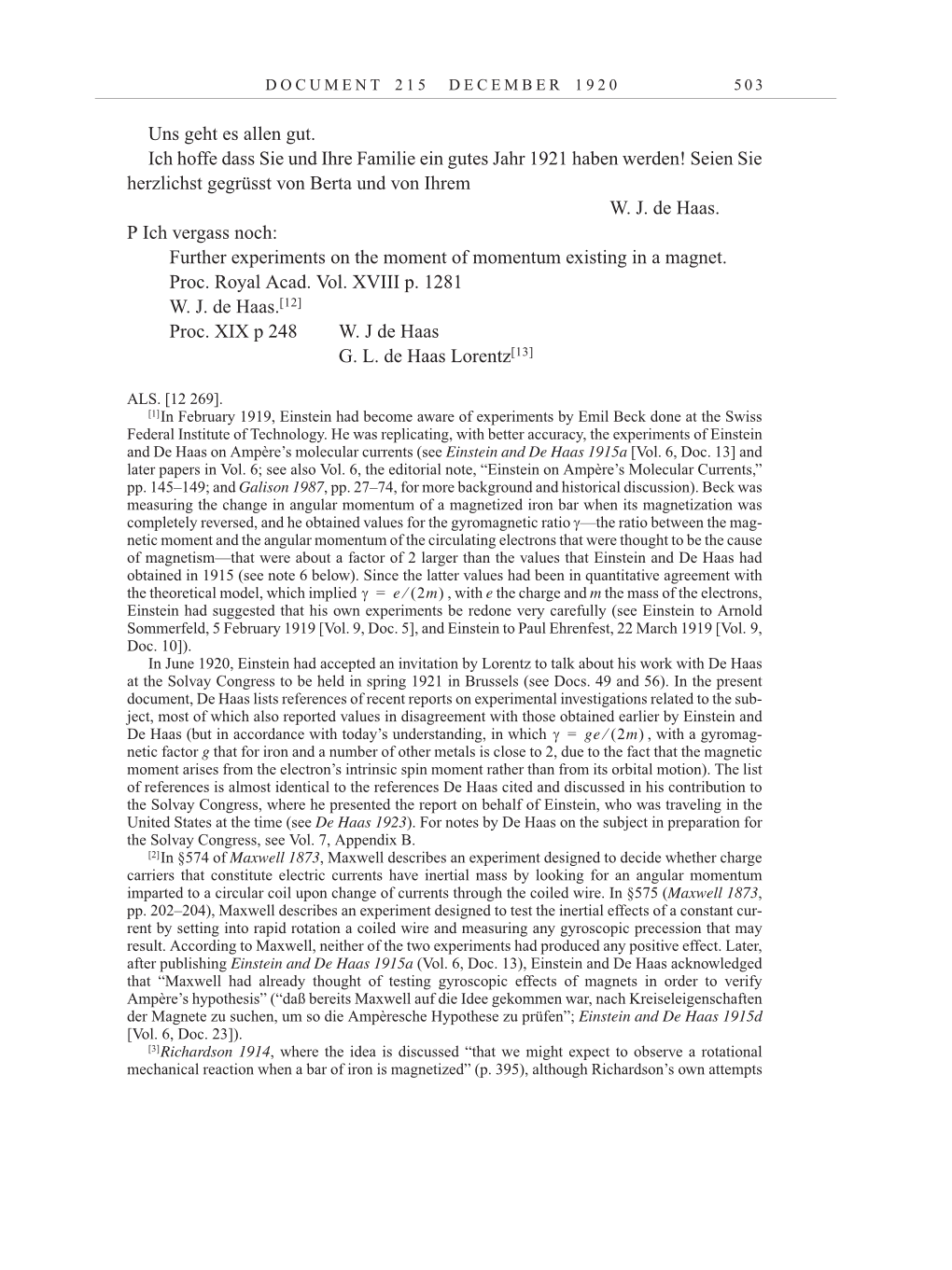D O C U M E N T 2 1 5 D E C E M B E R 1 9 2 0 5 0 3
Uns geht es allen gut.
Ich hoffe dass Sie und Ihre Familie ein gutes Jahr 1921 haben werden! Seien Sie
herzlichst gegrüsst von Berta und von Ihrem
W. J. de Haas.
P Ich vergass noch:
Further experiments on the moment of momentum existing in a magnet.
Proc. Royal Acad. Vol. XVIII p. 1281
W. J. de
Haas.[12]
Proc. XIX p 248 W. J de Haas
G. L. de Haas
Lorentz[13]
ALS. [12 269].
[1]In February 1919, Einstein had become aware of experiments by Emil Beck done at the Swiss
Federal Institute of Technology. He was replicating, with better accuracy, the experiments of Einstein
and De Haas on Ampère’s molecular currents (see Einstein and De Haas 1915a [Vol. 6, Doc. 13] and
later papers in Vol. 6; see also Vol. 6, the editorial note, “Einstein on Ampère’s Molecular Currents,”
pp. 145–149; and Galison 1987, pp. 27–74, for more background and historical discussion). Beck was
measuring the change in angular momentum of a magnetized iron bar when its magnetization was
completely reversed, and he obtained values for the gyromagnetic ratio —the ratio between the mag-
netic moment and the angular momentum of the circulating electrons that were thought to be the cause
of magnetism—that were about a factor of 2 larger than the values that Einstein and De Haas had
obtained in 1915 (see note 6 below). Since the latter values had been in quantitative agreement with
the theoretical model, which implied , with e the charge and m the mass of the electrons,
Einstein had suggested that his own experiments be redone very carefully (see Einstein to Arnold
Sommerfeld, 5 February 1919 [Vol. 9, Doc. 5], and Einstein to Paul Ehrenfest, 22 March 1919 [Vol. 9,
Doc. 10]).
In June 1920, Einstein had accepted an invitation by Lorentz to talk about his work with De Haas
at the Solvay Congress to be held in spring 1921 in Brussels (see Docs. 49 and 56). In the present
document, De Haas lists references of recent reports on experimental investigations related to the sub-
ject, most of which also reported values in disagreement with those obtained earlier by Einstein and
De Haas (but in accordance with today’s understanding, in which , with a gyromag-
netic factor g that for iron and a number of other metals is close to 2, due to the fact that the magnetic
moment arises from the electron’s intrinsic spin moment rather than from its orbital motion). The list
of references is almost identical to the references De Haas cited and discussed in his contribution to
the Solvay Congress, where he presented the report on behalf of Einstein, who was traveling in the
United States at the time (see De Haas 1923). For notes by De Haas on the subject in preparation for
the Solvay Congress, see Vol. 7, Appendix B.
[2]In §574 of Maxwell 1873, Maxwell describes an experiment designed to decide whether charge
carriers that constitute electric currents have inertial mass by looking for an angular momentum
imparted to a circular coil upon change of currents through the coiled wire. In §575 (Maxwell 1873,
pp. 202–204), Maxwell describes an experiment designed to test the inertial effects of a constant cur-
rent by setting into rapid rotation a coiled wire and measuring any gyroscopic precession that may
result. According to Maxwell, neither of the two experiments had produced any positive effect. Later,
after publishing Einstein and De Haas 1915a (Vol. 6, Doc. 13), Einstein and De Haas acknowledged
that “Maxwell had already thought of testing gyroscopic effects of magnets in order to verify
Ampère’s hypothesis” (“daß bereits Maxwell auf die Idee gekommen war, nach Kreiseleigenschaften
der Magnete zu suchen, um so die Ampèresche Hypothese zu prüfen”; Einstein and De Haas 1915d
[Vol. 6, Doc. 23]).
[3]Richardson 1914, where the idea is discussed “that we might expect to observe a rotational
mechanical reaction when a bar of iron is magnetized” (p. 395), although Richardson’s own attempts
e 2m =
ge 2m =
